Fire up your weekly meal prep game with smoky BBQ flavors that’ll transform your kitchen routine. We’re sharing game-changing strategies to bring authentic barbecue taste to your meal prep containers without spending hours at the grill every day.
BBQ meal prep isn’t just about convenience – it’s about maximizing flavor while minimizing your weeknight cooking stress. From perfectly seasoned proteins to smoky vegetable sides we’ll show you how to batch-cook restaurant-quality BBQ meals that actually taste better after a few days in the fridge.
Whether you’re craving tender pulled pork that melts in your mouth tangy BBQ chicken that packs a punch or creative plant-based options that satisfy every palate we’ve got the insider techniques that’ll make your meal prep containers the envy of your office break room.
Plan Your BBQ Meal Prep Success
Success in BBQ meal prep starts with smart planning and strategic choices. We’ll guide you through the essential elements that transform your weekly cooking routine into an efficient barbecue operation.
Choose the Right Proteins for Batch Cooking
Pork shoulder delivers the best value and flavor for large batch cooking. This cut becomes incredibly tender after slow cooking and actually improves in taste over 3-4 days in the refrigerator. We recommend purchasing 4-6 pound shoulders for optimal meal prep portions.
Chicken thighs outperform breasts for BBQ meal prep applications. Dark meat retains moisture better during reheating and absorbs smoky flavors more effectively. Bone-in thighs cost approximately 40% less than boneless breasts while providing superior texture.
Beef chuck roast transforms into pulled beef that rivals traditional brisket. This economical cut requires 6-8 hours of low-temperature cooking but yields enough protein for 12-15 meals. Chuck roast typically costs $3-4 less per pound than brisket.
Turkey legs offer an underutilized protein option for adventurous meal preppers. These large portions provide 2-3 servings each and develop rich, smoky flavors that intensify over time. We’ve found turkey legs work exceptionally well in BBQ sauce applications.
Select Versatile Vegetables That Reheat Well
Bell peppers maintain their texture and sweetness through multiple reheating cycles. Red, yellow, and orange varieties add vibrant colors to your meal prep containers while providing vitamin C and natural sugars that complement BBQ flavors.
Zucchini and yellow squash absorb BBQ seasonings without becoming mushy when reheated. We slice these vegetables into 1-inch rounds for even cooking and optimal storage. Both varieties reheat successfully in microwave or oven applications.
Sweet potatoes develop enhanced caramelization during the meal prep process. Their natural sugars concentrate over time, creating deeper flavors that pair perfectly with smoky meats. We recommend cutting sweet potatoes into uniform cubes for consistent cooking.
Brussels sprouts become tender and flavorful when prepared with BBQ techniques. Halved sprouts develop crispy edges during initial cooking and maintain excellent texture when reheated. These vegetables provide fiber and nutrients that balance rich BBQ proteins.
Invest in Quality Storage Containers
Glass containers with airtight lids preserve BBQ flavors better than plastic alternatives. We recommend 32-ounce rectangular containers that accommodate protein, vegetables, and sides in separated compartments. Glass doesn’t absorb odors or stains from BBQ sauces.
Vacuum-sealed bags extend the storage life of BBQ proteins by 2-3 additional days. These specialized bags remove air that causes oxidation and flavor loss. We use vacuum sealing for proteins intended for freezer storage beyond one week.
Silicone stretch lids provide flexible coverage for various container sizes and shapes. These reusable lids create tight seals on bowls, plates, and irregularly shaped containers. We keep multiple sizes available for different meal prep scenarios.
Portion control containers help maintain consistent serving sizes throughout the week. Color-coded systems with exact compartment sizes ensure balanced nutrition in each meal. We prefer containers with 1-cup protein sections and 0.5-cup vegetable compartments for optimal portion management.
Prepare Make-Ahead BBQ Protein Options
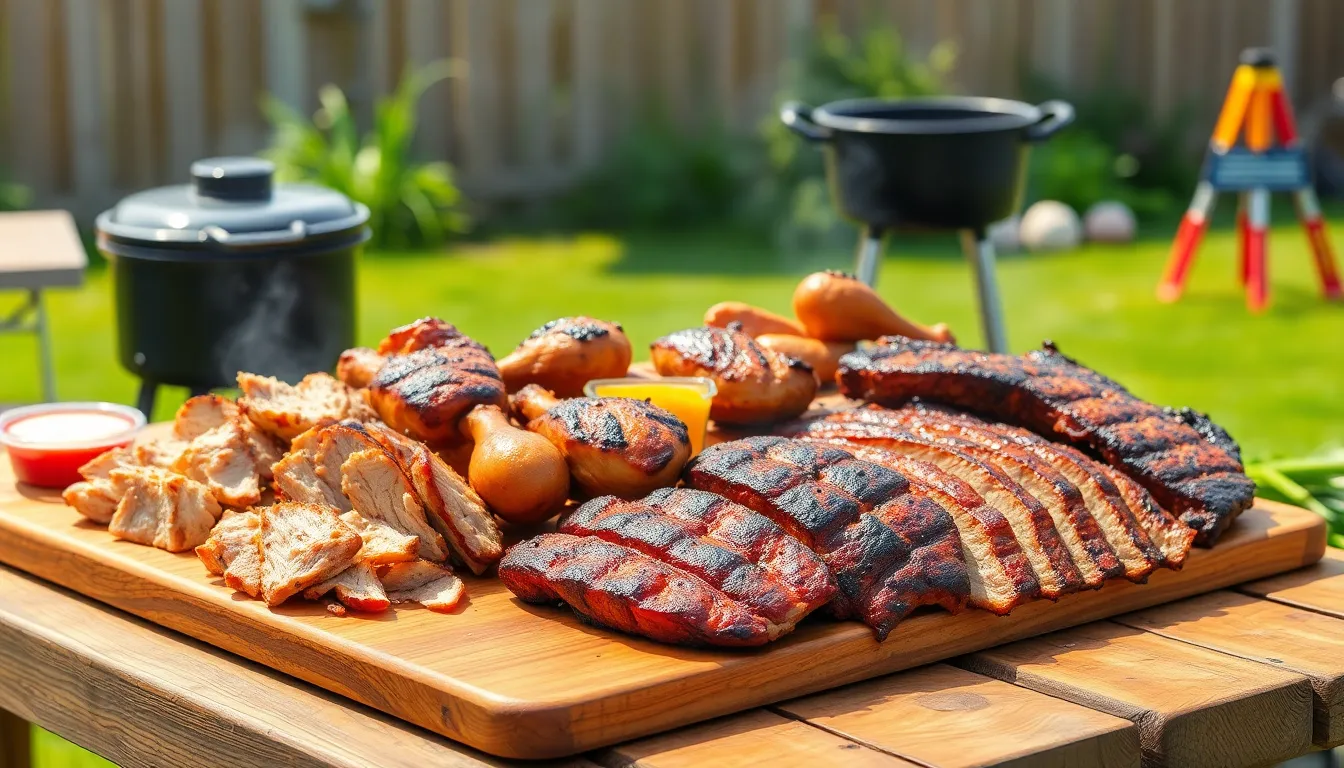
We’ll transform your BBQ meal prep with these protein-packed options that develop deeper flavors over time. Each protein choice maximizes efficiency while delivering restaurant-quality results throughout the week.
Slow-Cooked Pulled Pork for Multiple Meals
Slow-cooked pulled pork creates the ultimate meal prep foundation, working beautifully in slow cookers or ovens over several hours. We love how this tender protein maintains its moisture and flavor profile, making it perfect for sandwiches, tacos, or salad toppings throughout multiple days.
Batch cooking allows us to portion and freeze portions for future meals, dramatically reducing BBQ day preparation time. Pork shoulder transforms into fork-tender perfection when cooked low and slow, developing complex flavors that actually improve after refrigeration.
Grilled Chicken Breast Variations
Grilled chicken breasts offer incredible versatility when marinated in advance with options like zesty lemon, fresh cilantro-lime, or smoky BBQ sauce combinations. We recommend grilling large batches then slicing or cubing the meat for various applications throughout the week.
This lean protein keeps exceptionally well when refrigerated for several days or frozen for extended storage periods. Marinated chicken develops enhanced flavors during storage, making it ideal for wraps, salads, or standalone meals that taste better than fresh-cooked options.
Smoked Brisket Portions
Smoked brisket represents premium meal prep potential when prepared using low and slow smoking techniques that ensure tender, flavorful results. We find that properly smoked brisket maintains its moisture content and develops richer flavors after initial preparation.
Sliced brisket works perfectly for sandwiches, plated dinners, or mixed BBQ combinations that showcase this premium protein. Freezing capabilities make brisket an excellent investment protein, reheating beautifully without losing essential moisture or texture quality.
BBQ Meatballs and Sausages
BBQ meatballs made from ground turkey or beef combined with signature BBQ seasonings create convenient make-ahead options that freeze exceptionally well. We prepare large batches that reheat quickly for standalone meals, hearty sandwiches, or slider presentations with melted cheese additions.
Pre-cooked sausages offer similar convenience when grilled, cooled, and stored properly for quick reheating during BBQ events. Both options provide protein variety while maintaining consistent quality and flavor profiles that complement traditional BBQ side dishes perfectly.
Create BBQ-Inspired Grain and Starch Bases
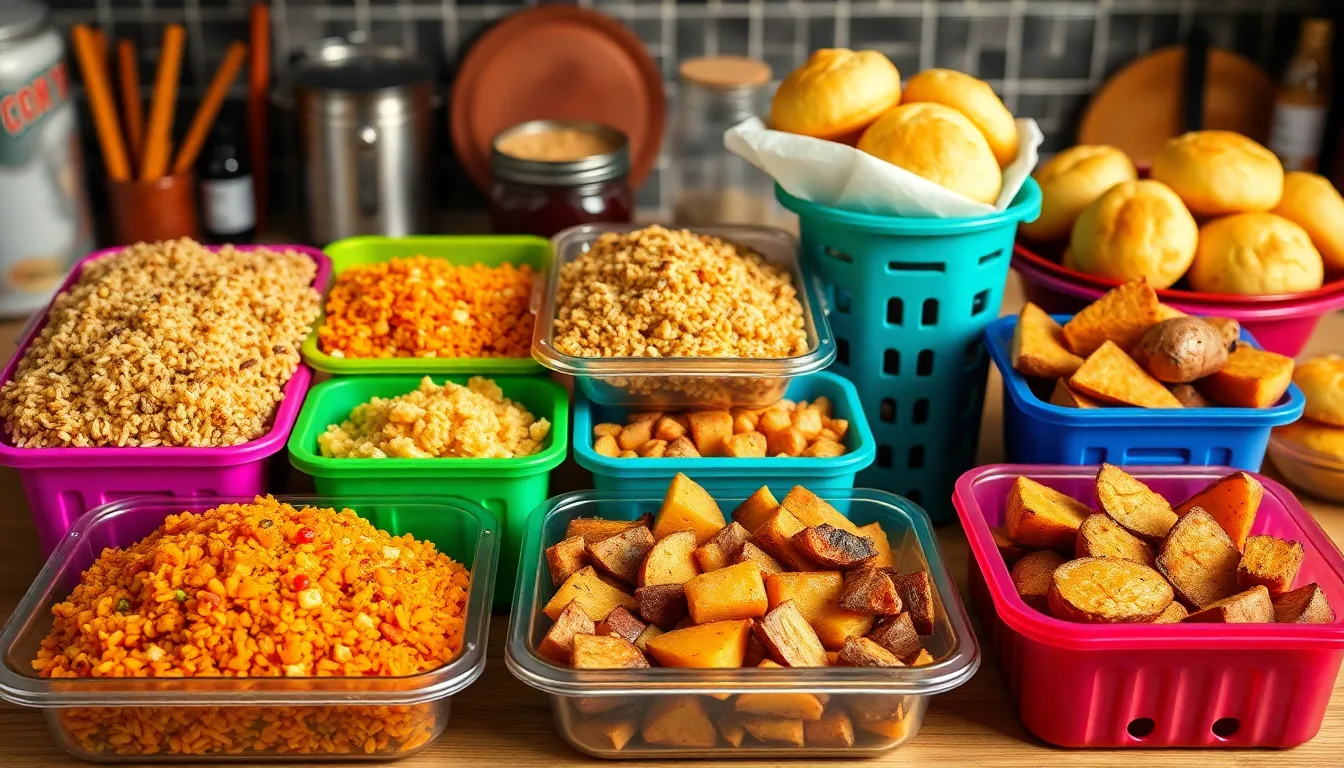
Building our meal prep containers requires sturdy foundations that complement smoky BBQ proteins. We’ll transform ordinary grains and starches into flavor-packed bases that absorb BBQ essences while providing satisfying substance for the week ahead.
Seasoned Rice and Quinoa Blends
Rice and quinoa serve as perfect canvases for incorporating smoky BBQ seasonings directly into our meal prep foundations. We blend these nutritious grains with smoked paprika, garlic powder, onion powder, oregano, and thyme to echo authentic barbecue flavors. Cook large batches using a 2:1 liquid-to-grain ratio, adding our seasoning blend during the cooking process for maximum flavor penetration.
Brown rice provides hearty texture and nutty undertones that pair beautifully with pulled pork and brisket. Quinoa offers complete protein and fluffy consistency that complements grilled chicken variations. We can swap between these options throughout the week to maintain variety while keeping our BBQ meal prep containers interesting and nutritionally balanced.
Roasted Sweet Potato and Regular Potato Options
Potatoes represent classic BBQ accompaniments that excel in meal prep applications due to their versatility and storage capabilities. We dice regular potatoes or sweet potatoes into uniform pieces, toss them with olive oil, and season generously with smoked paprika, garlic powder, onion powder, oregano, thyme, salt, and pepper.
Roasting these seasoned potatoes at 425°F for 25-30 minutes creates crispy exteriors and tender interiors that hold up beautifully in refrigerated containers. Sweet potatoes contribute natural sweetness that balances savory BBQ elements, while regular potatoes provide traditional heartiness. Air frying offers an alternative cooking method that produces similarly excellent results in less time.
Cornbread and Biscuit Preparations
Cornbread and biscuits bring authentic BBQ restaurant vibes to our meal prep containers while serving as excellent vehicles for soaking up barbecue sauces. We prepare these baked goods in advance, portioning them into individual servings that complement our weekly BBQ protein selections.
Cornbread’s slightly sweet, crumbly texture creates perfect contrast against smoky meats and tangy sauces. Biscuits add flaky, buttery richness that enhances the overall meal experience. Flavor these staples with jalapeños for heat, cheddar cheese for richness, or fresh herbs for aromatic complexity that elevates standard BBQ accompaniments into memorable meal prep components.
Batch Cook BBQ Vegetable Sides
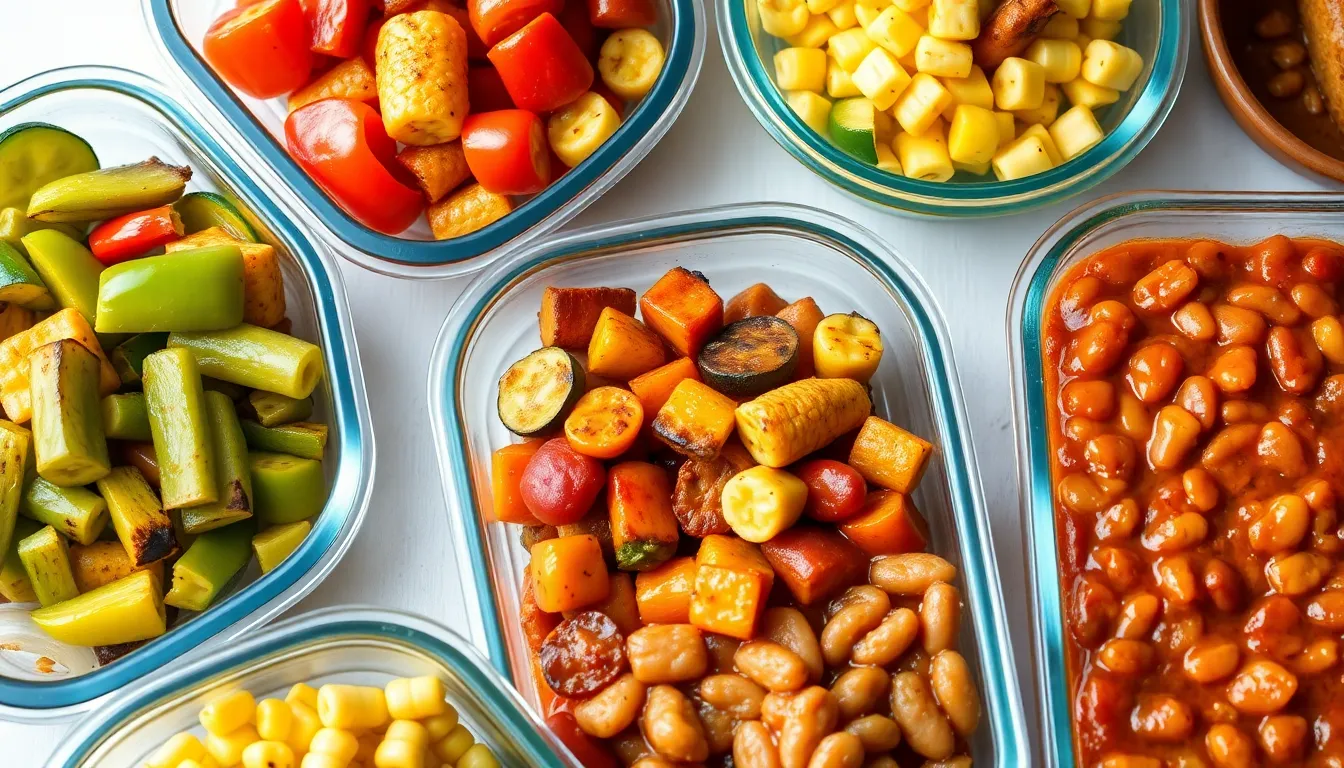
Vegetables become the perfect canvas for BBQ flavors when we prepare them in large batches alongside our proteins. These smoky, seasoned sides store beautifully and actually taste better after absorbing those bold BBQ seasonings overnight.
Grilled Bell Peppers and Onions
Grilled bell peppers and onions create a colorful foundation for countless BBQ meal combinations. We slice both vegetables into thick strips to prevent them from falling through grill grates while maintaining that perfect tender texture. Tossing them with olive oil, salt, pepper, and smoked paprika before grilling adds depth to their natural sweetness.
Fire up your grill to medium heat and cook these vegetables until they develop light char marks and become tender throughout. We typically prepare 4 to 6 bell peppers and 3 large onions at once, which provides enough sides for an entire week of meals. Store them in airtight glass containers where they’ll keep fresh for up to 5 days.
These versatile vegetables work beautifully as sandwich toppings, bowl additions, or standalone sides that complement any BBQ protein we’ve prepared.
Roasted Corn and Zucchini Medleys
Roasted corn and zucchini medleys bring summer BBQ vibes to our meal prep rotation year round. We cut zucchini into uniform half moon shapes and remove corn kernels from the cob for even cooking and easy storage. Seasoning this combination with olive oil, garlic powder, smoked paprika, salt, and pepper creates a vibrant side dish that pairs perfectly with our batch cooked proteins.
Roasting at 425°F for 20 to 25 minutes develops caramelized edges while keeping the vegetables tender inside. We prepare enough for 8 to 10 servings at once, portioning them into individual containers for grab and go convenience.
This medley reheats wonderfully in the microwave and adds natural sweetness that balances the bold flavors of BBQ chicken, pulled pork, or grilled sausages.
BBQ Baked Beans Variations
BBQ baked beans variations transform this classic side into a protein rich meal component that improves with time. We start with navy or pinto beans as our base, then customize flavors to match our weekly meal themes. Traditional versions include BBQ sauce, diced onions, brown sugar, and smoky spices that create that signature tangy sweet profile.
Creating variations keeps our meal prep interesting throughout the week. We add crumbled bacon or smoked sausage for meat lovers, mushrooms and liquid smoke for vegetarian options, or jalapeños and chipotle peppers for spicy kicks. One large batch typically yields 12 to 15 servings that freeze beautifully for future weeks.
Slow cooking these beans for 3 to 4 hours allows flavors to meld completely, creating a rich side dish that complements any BBQ protein while providing substantial nutrition to our meal prep containers.
Assemble Ready-to-Heat BBQ Meal Combinations
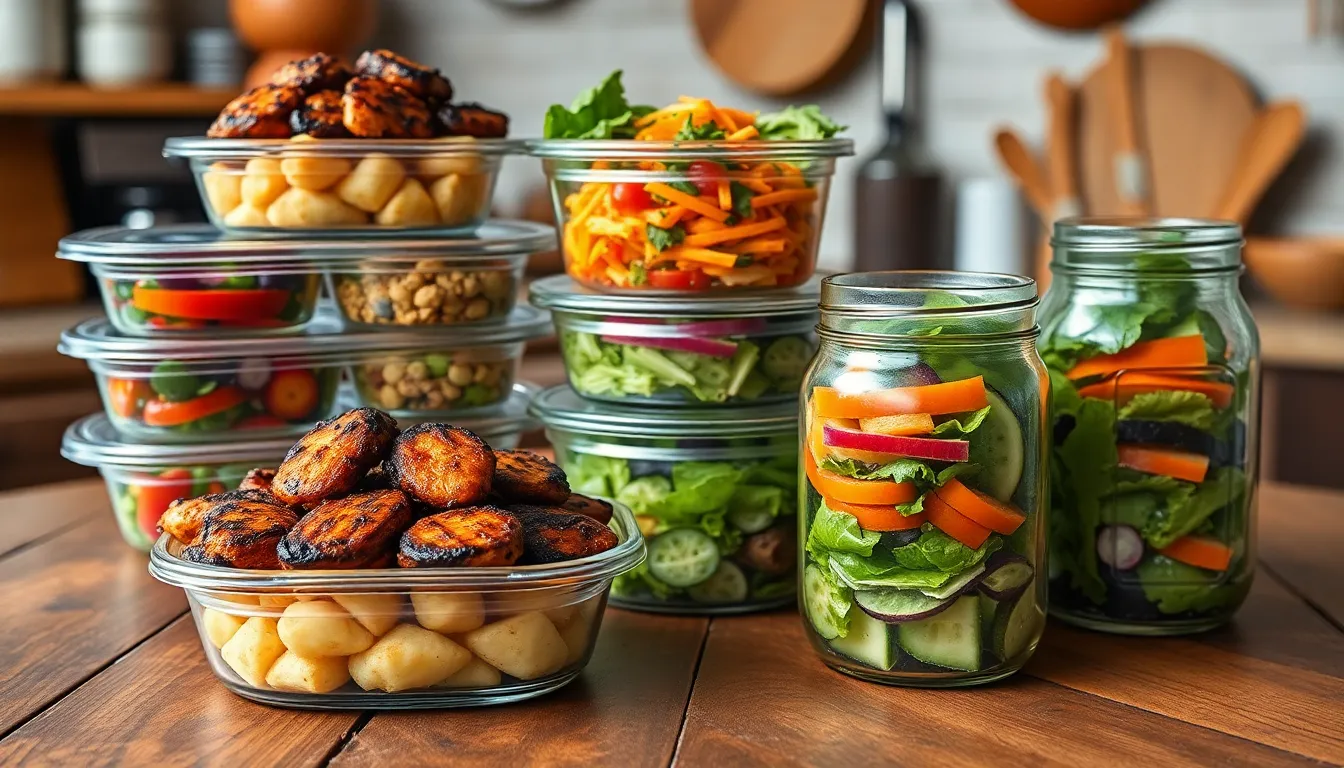
Creating complete BBQ meal combinations ahead of time transforms our weekly meal prep into a stress-free experience. These ready-to-heat combinations feature smoky BBQ chicken breasts served over garlicky smashed potatoes with sides like Parmesan cream corn and green beans with whipped herb butter.
BBQ Protein Bowls with Grains
Balance becomes effortless when we create BBQ protein bowls with wholesome grains as our foundation. Rice and quinoa provide excellent bases for grilled chicken, ribs, or shrimp while absorbing the smoky flavors we love. Fresh vegetables add color and nutrition to each bowl, making them visually appealing and satisfying.
Drizzle chipotle-whiskey sauce or traditional BBQ sauce over the assembled bowls for that authentic barbecue taste. Grilled Cajun shrimp kabobs bring bold flavors that complement the grain base perfectly. Chicken with chipotle-whiskey BBQ sauce delivers smoky depth that improves after marinating in the fridge overnight.
Portion these bowls into individual containers for grab-and-go convenience throughout the week. Mix and match proteins with different grains to prevent meal fatigue while maintaining that signature BBQ essence.
Sheet Pan BBQ Dinners
Combine BBQ meats like sirloin tips and chicken thighs with seasonal vegetables on single sheet pans for minimal cleanup. This method streamlines our prep process while ensuring everything cooks evenly together. Marinating meats beforehand infuses deeper flavors that develop beautifully during roasting or grilling.
Roast everything simultaneously to save time and create perfectly coordinated meals. Sheet pan dinners work exceptionally well for gatherings and can be easily portioned into meal prep containers afterward. Bell peppers, zucchini, and sweet potatoes pair wonderfully with BBQ proteins on these one-pan meals.
Store portioned sheet pan dinners in glass containers where they’ll maintain their flavors and textures for up to four days. Reheating these complete meals takes just minutes in the oven or microwave.
Mason Jar BBQ Salads
Layer grilled chicken, steak, or ribs at the bottom of mason jars to create portable BBQ salads. Beans and corn add protein and sweetness while grilled peppers contribute smoky notes that enhance the overall flavor profile. Leafy greens stay fresh when placed at the top of each jar.
Keep dressings separate until serving time to prevent soggy greens and maintain crisp textures. These salads offer complete customization options for different dietary preferences and taste requirements. Mason jars preserve freshness for up to five days when properly assembled and refrigerated.
Pack these ready-to-eat salads for work lunches or quick dinners when cooking isn’t an option. Simply shake the jar before eating to distribute the dressing evenly throughout all layers.
Freezer-Friendly BBQ Casseroles
Assemble hearty casseroles that combine BBQ meats with grains like rice or pasta, cheese, and vegetables for ultimate comfort food. These casseroles freeze beautifully in individual portions, providing easy access to homemade BBQ meals without daily cooking requirements. Popular proteins include chicken thighs, baby back ribs, sirloin tips, and flank steak.
Enhance flavor depth using marinades and sauces like chipotle-whiskey BBQ or coffee-bourbon BBQ before assembling the casseroles. These bold flavors typical of great BBQ meals intensify during the freezing and reheating process. Vegetables like bell peppers and sweet potatoes maintain their texture well in frozen casseroles.
Bake or reheat these casseroles directly from the freezer for convenience when time is limited. Individual portions ensure we can enjoy BBQ comfort food whenever cravings strike without preparing entire batches.
Master BBQ Sauce and Seasoning Prep
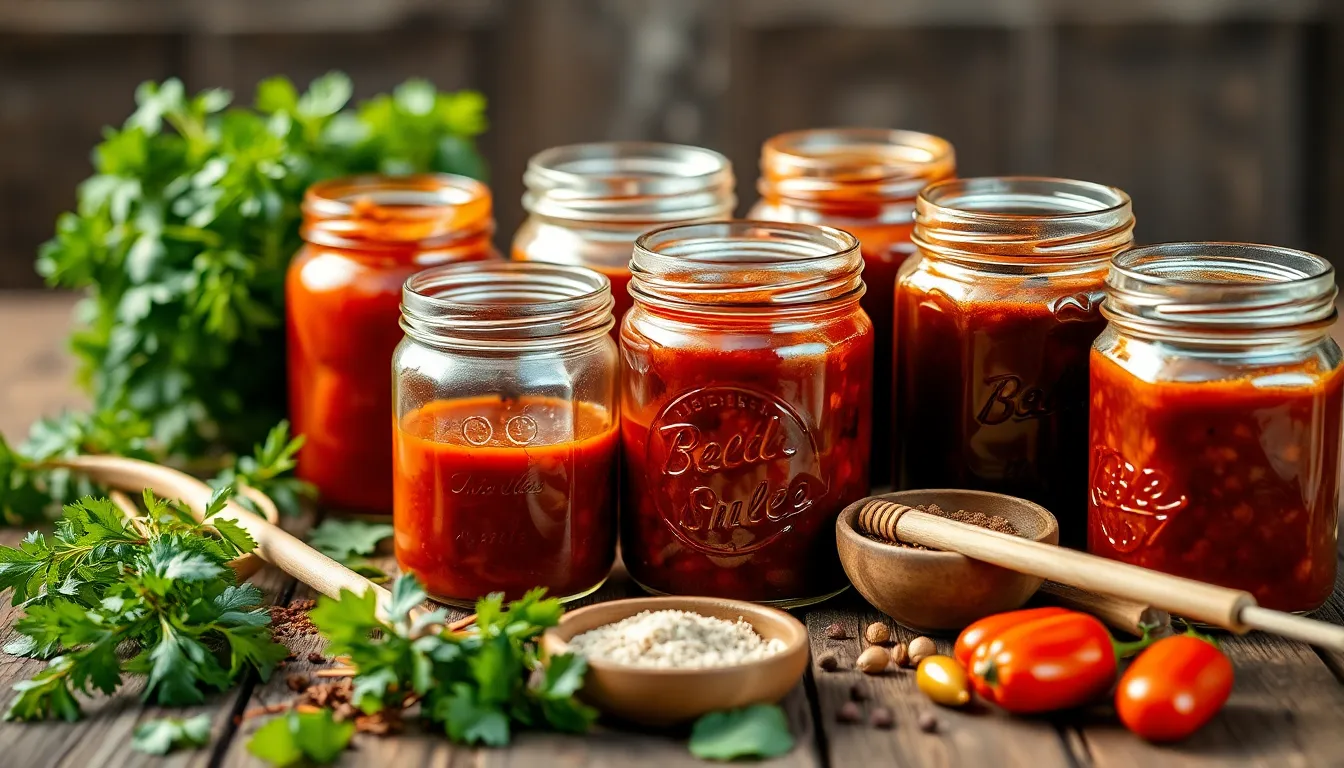
Building authentic BBQ flavors starts with mastering your sauce and seasoning foundations. We’ll transform your meal prep game by creating homemade blends that develop deeper flavors over time.
Homemade BBQ Sauce Varieties
Classic BBQ Sauce delivers the perfect balance we all crave, combining tomato base with vinegar’s tang and brown sugar’s sweetness. Ketchup or tomato sauce forms the foundation, while smoked paprika, chili powder, garlic powder, and black pepper create that signature depth.
Smoky Chipotle Sauce elevates heat levels with chipotle peppers that infuse both fire and smokiness into every drop. This variety works exceptionally well with beef proteins and holds up beautifully in meal prep containers.
Honey Garlic Sauce marries sweetness and savory elements through honey’s natural sugars and fresh garlic’s pungent bite. Chicken thighs and pork shoulder absorb these flavors magnificently during storage.
Carolina Gold Sauce breaks traditional rules by using mustard as its tangy, sharp base that pairs perfectly with pork dishes. This yellow sauce variety adds visual appeal and distinctive flavor to your weekly prep rotation.
Spicy Variations can transform any base recipe by incorporating chili flakes or hot sauce to match your heat tolerance. We recommend starting with small amounts since flavors intensify during refrigeration.
Dry Rub Spice Blends
Essential Dry Rub Components include smoked paprika, brown sugar, garlic powder, onion powder, black pepper, cayenne pepper, cumin, oregano, and thyme for maximum flavor impact. These spice mixtures coat proteins evenly and form flavorful crusts during cooking.
Balancing Sweet and Smoky Elements requires careful measurement of brown sugar against smoked paprika to achieve that perfect BBQ profile. Too much sweetness overwhelms the smoke, while insufficient sugar prevents proper caramelization.
Application Techniques work best when you massage dry rubs into proteins at least 30 minutes before cooking, allowing spices to penetrate meat fibers. Ribs, chicken, brisket, pork shoulder, and vegetables all benefit from this treatment method.
Storage Tips keep your custom blends fresh in airtight containers for up to six months, maintaining potency for consistent meal prep results. Label each blend with ingredients and creation dates for easy identification.
Marinade Answers for Quick Flavoring
Basic Marinade Formula combines acid sources like vinegar or citrus juice with oil and your chosen seasonings for maximum flavor penetration. Apple cider vinegar, olive oil, garlic, smoked paprika, salt, and pepper create an excellent starting point.
Time Requirements vary by protein type, with chicken breasts and seafood needing only 30 minutes to two hours for optimal results. Longer marinating times can break down protein structures, especially in delicate fish.
Acid Balance determines marinade effectiveness, as too much acid toughens proteins while insufficient amounts limit flavor absorption. We recommend a 3:1 oil to acid ratio for most applications.
Prep Friendly Options include vacuum sealing marinated proteins for extended storage, allowing flavors to develop while maintaining food safety standards. This technique works particularly well for chicken thighs and pork cuts destined for weekly meal rotation.
Store and Reheat Your BBQ Meal Preps
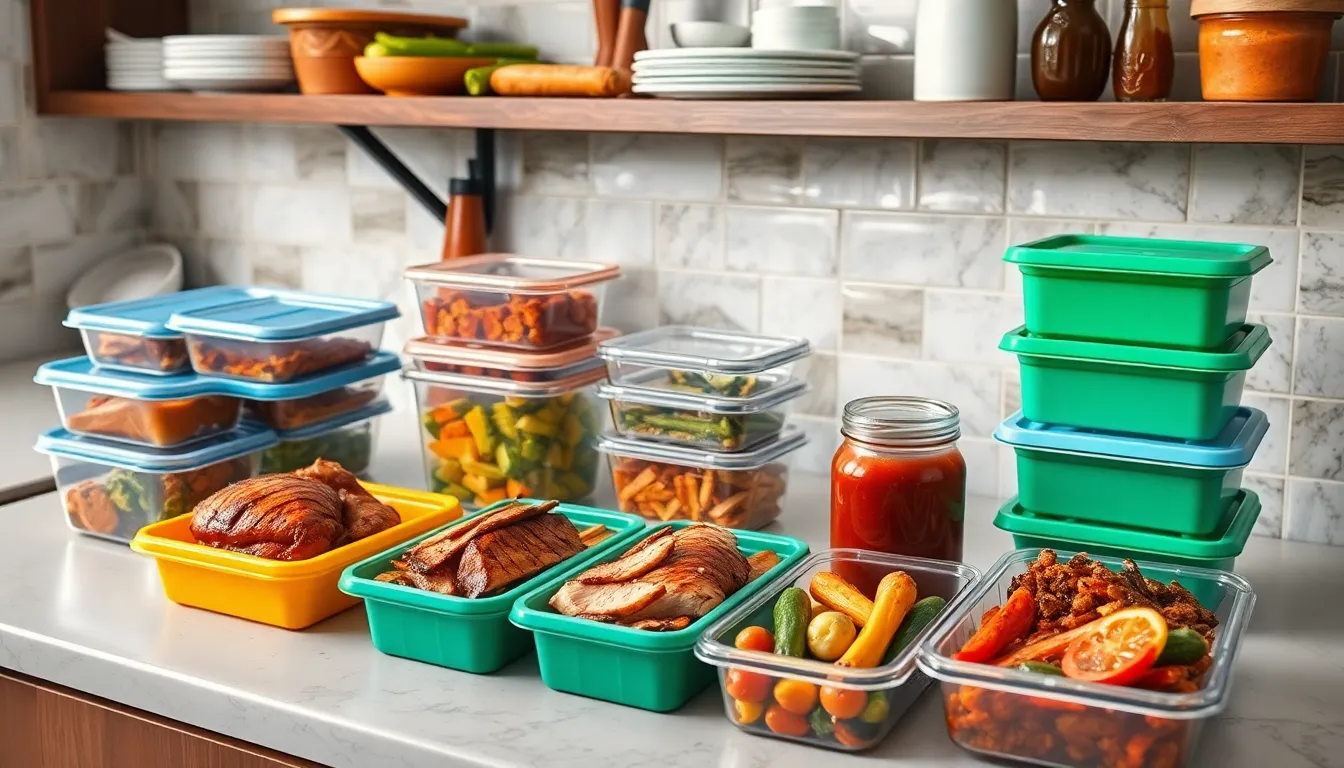
Storing your carefully prepared BBQ meals correctly ensures they’ll taste just as delicious days later. We’ve found that proper storage and reheating techniques can make or break your meal prep success.
Proper Storage Techniques for Maximum Freshness
Cool your BBQ meals completely before placing them in the refrigerator to prevent condensation that makes food soggy. Letting grilled chicken, potatoes, and vegetables reach room temperature first preserves their texture and prevents bacterial growth.
Use airtight containers to minimize exposure to air and moisture that can degrade your BBQ flavors. Glass containers with secure lids work best for maintaining the smoky taste of your prepared meats and vegetables.
Store sauces separately from your main components to avoid soggy ingredients throughout the week. Keep your homemade BBQ sauces, Carolina Gold sauce, and spicy variations in small containers until you’re ready to reheat and serve.
Refrigerate within two hours of cooking to ensure food safety and maintain optimal freshness. This timing is especially important for proteins like pulled pork, grilled chicken thighs, and smoked brisket that can harbor bacteria if left at room temperature too long.
Reheating Methods That Preserve Flavor
Oven or air fryer reheating works best for maintaining the crispy texture of your BBQ potatoes and grilled meats. Set your temperature to 350°F/175°C to avoid drying out proteins while restoring that perfect exterior crunch.
Microwave with moisture by covering meals loosely and adding a splash of water to retain the juiciness of your BBQ chicken and pulled pork. Avoid overheating which can toughen meats and ruin the texture you worked hard to achieve.
Warm sauces separately on the stove or in the microwave before adding them back to your reheated proteins. This technique keeps your homemade BBQ sauces at their optimal consistency and prevents them from burning onto your meats.
Limit reheating to once to prevent quality degradation and maintain food safety standards. Multiple heating cycles can break down proteins and create potential health risks with your carefully prepared BBQ meals.
Freezing Guidelines for Long-Term Storage
Cool completely before freezing to prevent ice crystals from forming and damaging the texture of your BBQ meal preps. Rushing this step can result in mushy vegetables and tough meats when you’re ready to enjoy your frozen meals.
Use freezer-safe containers or heavy-duty freezer bags to protect your BBQ creations from freezer burn. Remove as much air as possible to maintain the smoky flavors you’ve developed in your pulled pork, chicken, and vegetable combinations.
Label containers with dates and contents for easy rotation and meal planning throughout the month. Mark your BBQ protein bowls, casseroles, and individual portions clearly to avoid mystery meals later.
Freeze in individual portions to allow thawing and reheating only what you need for each meal. This approach prevents waste and lets you enjoy perfectly sized servings of your BBQ chicken breasts, smashed potatoes, and roasted vegetables.
Thaw safely in the refrigerator overnight or use your microwave’s defrost setting before reheating. Proper thawing maintains the quality of your BBQ meal preps and ensures even heating when you’re ready to enjoy them.
Conclusion
BBQ meal prep transforms our weekly cooking routine by bringing restaurant-quality flavors to our home kitchens. We’ve discovered that the key lies in strategic planning and understanding which proteins and vegetables actually improve with time.
The techniques we’ve explored – from mastering homemade sauces to proper storage methods – ensure our BBQ meals stay delicious throughout the week. These make-ahead strategies save us precious time while delivering the smoky satisfaction we crave.
With the right containers and reheating methods our BBQ creations maintain their authentic taste and texture. We’re now equipped to enjoy flavorful BBQ meals any day of the week without the weeknight stress.
Frequently Asked Questions
What proteins work best for BBQ meal prep?
Pork shoulder, chicken thighs, beef chuck roast, and turkey legs are ideal for BBQ meal prep. These cuts become more tender and flavorful after a few days in the fridge. Pork shoulder offers exceptional tenderness, chicken thighs retain moisture better than breasts, beef chuck creates economical pulled beef, and turkey legs provide rich, smoky flavors.
How long do BBQ meal prep containers last in the refrigerator?
Properly stored BBQ meal prep containers typically last 3-4 days in the refrigerator when kept in airtight containers. Many BBQ dishes actually improve in flavor during this time as the spices and sauces have more time to penetrate the proteins and vegetables, making them perfect for weekly meal prep.
What vegetables reheat well with BBQ flavors?
Bell peppers, zucchini, yellow squash, sweet potatoes, and Brussels sprouts are excellent choices for BBQ meal prep. These vegetables maintain their texture when reheated and absorb smoky BBQ flavors beautifully. They complement BBQ proteins perfectly and actually taste better after marinating in the flavors overnight.
Should I store BBQ sauce separately from the meal?
Yes, store BBQ sauce separately when possible to prevent sogginess and maintain optimal texture. Keep sauces in small containers and add them when reheating. This prevents proteins and vegetables from becoming mushy and allows you to control the sauce amount for each meal while maintaining freshness.
What’s the best way to reheat BBQ meal prep?
Use an oven or air fryer at 350°F to reheat BBQ meals, as this preserves texture better than microwaving. Heat proteins separately from vegetables when possible, and add sauce during the last few minutes. Cover with foil to prevent drying out, and heat until internal temperature reaches 165°F.
Can I freeze BBQ meal prep containers?
Yes, most BBQ meal prep containers freeze well for up to 3 months. Use freezer-safe containers, leave space for expansion, and label with contents and date. Thaw overnight in the refrigerator before reheating. Avoid freezing meals with high water content vegetables like lettuce or tomatoes for best results.
How do I make homemade BBQ sauce for meal prep?
Start with a base of ketchup, apple cider vinegar, brown sugar, and Worcestershire sauce. Add smoky spices like paprika, chipotle powder, and garlic. Simmer for 15-20 minutes until thickened. Make large batches and store in the refrigerator for up to two weeks or freeze for longer storage.
What storage containers work best for BBQ meal prep?
Glass containers with airtight lids are ideal for BBQ meal prep as they don’t absorb odors or stains. Vacuum-sealed bags work great for freezer storage, while silicone stretch lids offer flexible coverage. Portion control containers help maintain balanced nutrition and proper serving sizes throughout the week.







